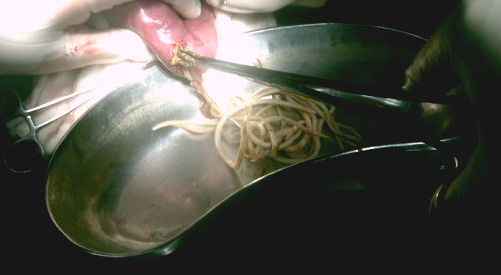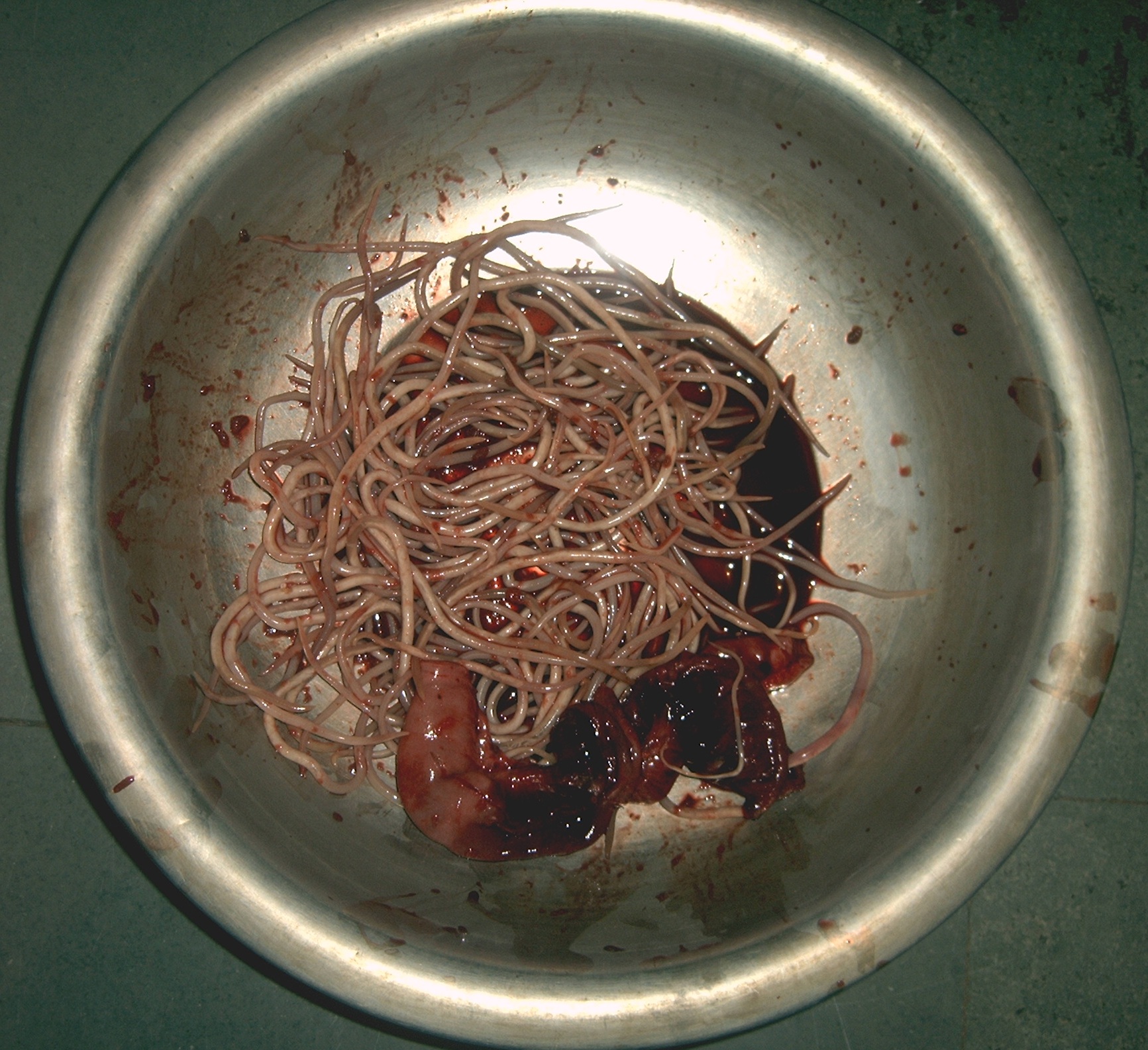Ascariasis laboratory tests
|
Ascariasis Microchapters |
|
Diagnosis |
|---|
|
Treatment |
|
Case Studies |
|
Ascariasis laboratory tests On the Web |
|
American Roentgen Ray Society Images of Ascariasis laboratory tests |
|
Risk calculators and risk factors for Ascariasis laboratory tests |
Editor-In-Chief: C. Michael Gibson, M.S., M.D. [1]Associate Editor(s)-in-Chief: Fatimo Biobaku M.B.B.S [2]
Overview
Ascariasis is frequently diagnosed in the laboratory via microscopic identification of eggs in the feces.[1]
Laboratory Findings
The diagnosis of ascariasis can be done via the following methods:[1][2]
- Microscopic identification of eggs in the stool is the common method for diagnosing ascariasis and simple smears are often adequate because of the high output of eggs produced daily by gravid female worms. Stool concentration procedures such as Kato-Katz thick smear or formalin-ethyl acetate sedimentation can also be done. Ascaris larvae can also be found in sputum or gastric aspirates during pulmonary migration, before eggs are present in feces.
- Adult worms are occasionally passed in the stool or through the mouth or nose and are easily recognizable by their macroscopic characteristics.
- Polymerase chain reaction (PCR)- based asssays can identify and quantify the DNA of Ascaris.
- Serology- This is more useful for epidemiologic purposes than for individual diagnosis because the IgG antibodies developed by patients cross react with the antigens from other helminths
- Eosinophilia- This is a non-specific finding that is not used solely for diagnosis. Eosinophilia is usually more prominent during early infection but often subsides in established adult worm infestation in the intestines. Eosinophilia is often in the 5-10% range but can rise as high as 50%.
Macroscopic Findings
Ascaris lumbricoides is easily identified because of the large size and non-segmented cream-colored cuticle.
Images courtesy of Dr. Imtiaz Ahmed Wani
-
Enterotomy for worm removal
-
Ascaris lumbricoides caused gangrene of ileum (shown worms removed from a child)
Microscopic Findings
Below are several Ascaris eggs seen in wet mounts. Diagnostic characteristics:
Fertilized eggs (A, B on the right, D, F, G, H) are rounded, have a thick shell, with an external mammillated layer that is often stained brown by bile. In some cases, the outer layer is absent (decorticated eggs:E, F on the right, G). Size: approximately 60 µm in diameter when spherical, and up to 75 µm when ovoid.
Unfertilized eggs (B on the left, C, E) are elongated and larger (up to 90 µm in length); their shell is thinner; and their mammillated layer is more variable, either with large protuberances (C) or practically none (E); these eggs contain mainly a mass of refractile granules.
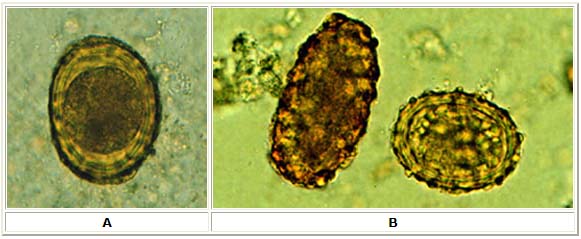
A: Fertilized Ascaris egg, still at the unicellular stage. Eggs are normally at this stage when passed in the stool. Complete development of the larva requires 18 days under favorable conditions.
B: Unfertilized and fertilized eggs (left and right, respectively).
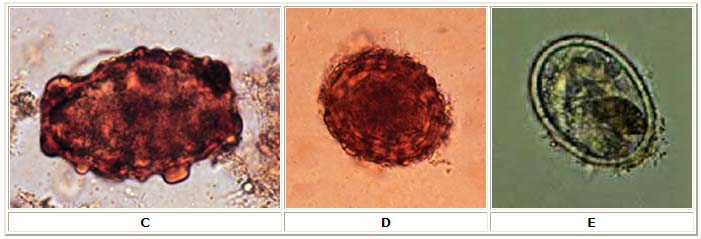
C: Unfertilized egg. Prominent mammillations of outer layer.
D: Fertilized egg. The embryo can be distinguished inside the egg.
E: Unfertilized egg with no outer mammillated layer (decorticated).
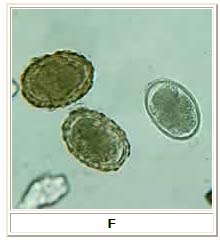
F: Three fertilized eggs (one decorticated, on the right) of Ascaris lumbricoides.
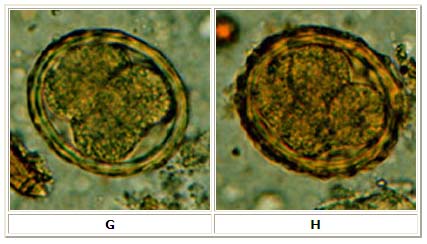
G, H: Two fertilized eggs from the same patient, where embryos have begun to develop (this happens when the stool sample is not processed for several days without refrigeration). The embryos in early stage of division (4 to 6 cells) can be clearly seen. Note that the egg in G has a very thin mammillated outer layer.
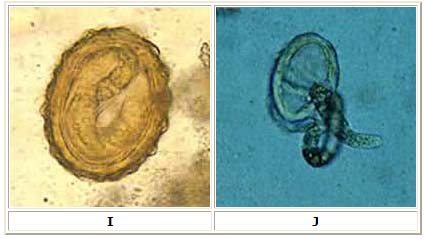
I: Egg containing a larva, which will be infective if ingested.
J: Larva hatching from an egg.
References
- ↑ 1.0 1.1 Durand, Marlene (2015). "Chapter 288:Intestinal Nematodes (Roundworms)". Mandell, Douglas, and Bennett's Principles and Practice of Infectious Diseases Updated Edition, Eighth Edition. Elsevier. pp. 3199–3207. ISBN 978-1-4557-4801-3.
- ↑ Ferri, Fred (2017). "Chapter:Ascariasis". Ferri's Clinical Advisor 2017. Elsevier. pp. 117–117. ISBN 978-0-3232-8048-8.
